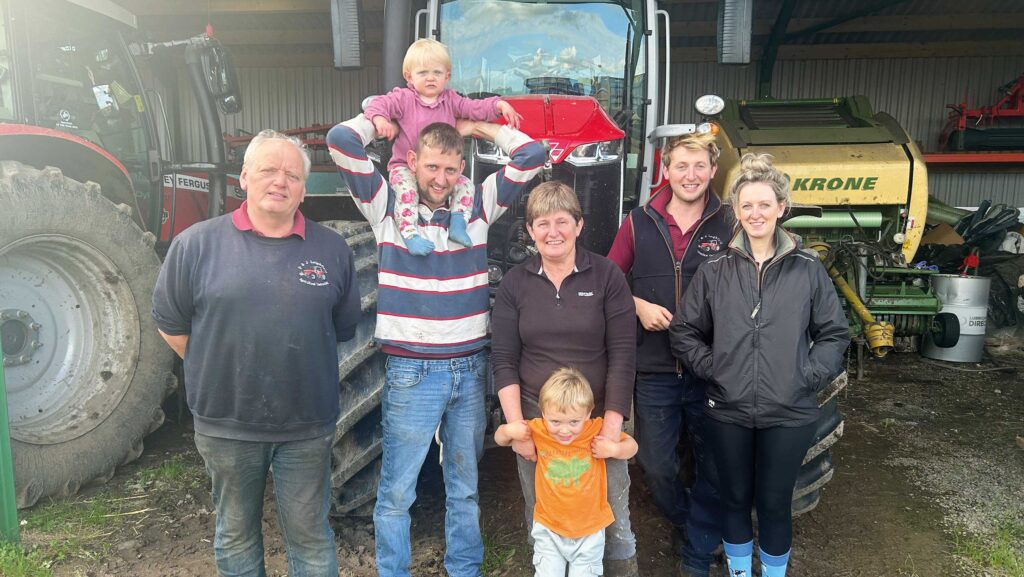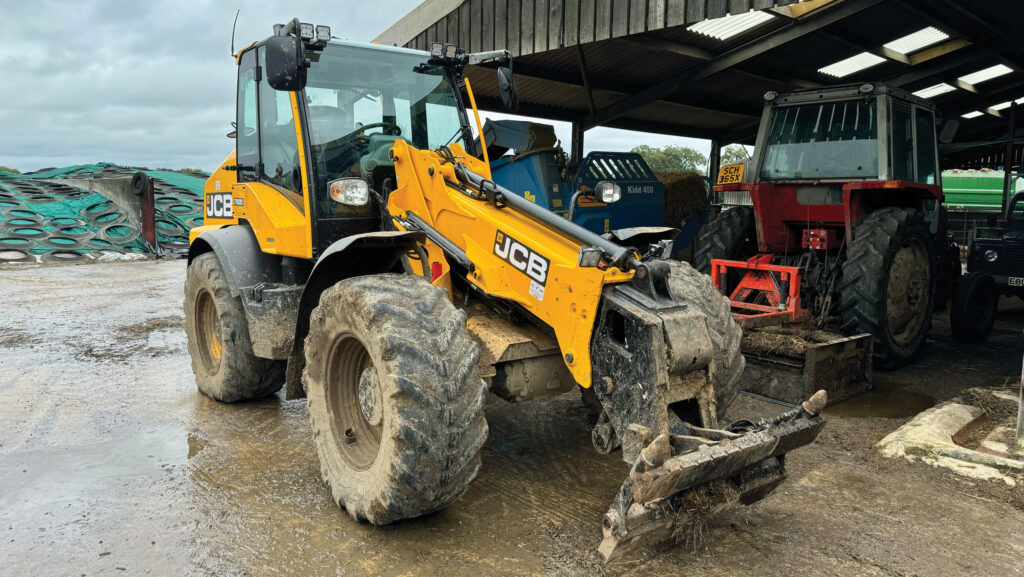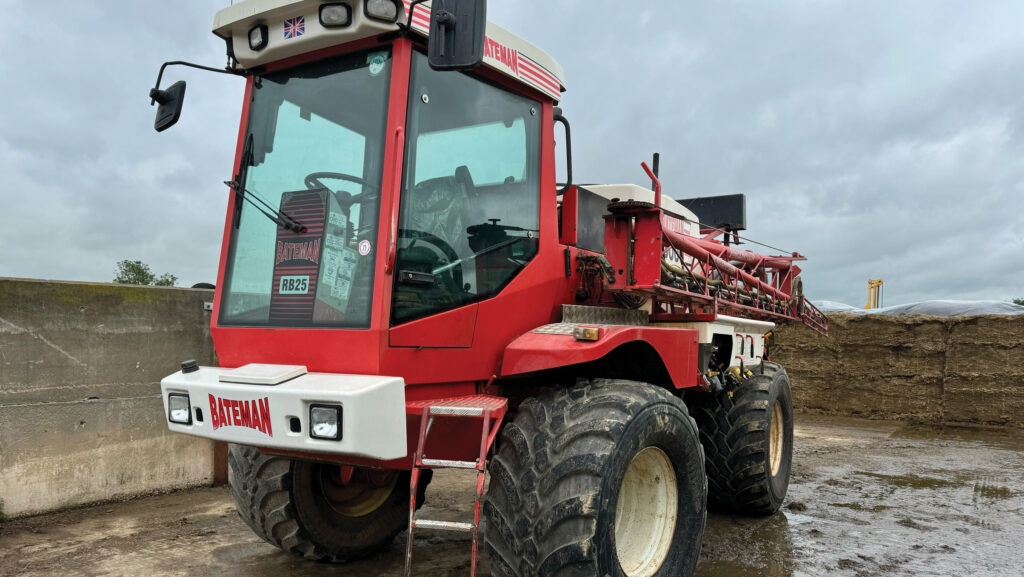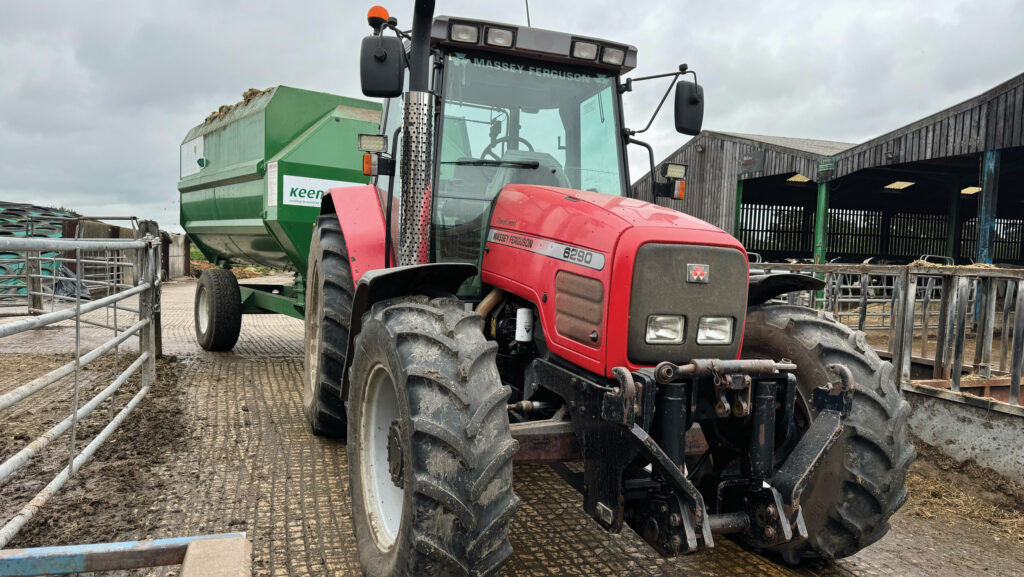What’s in Your Shed? visits Wiltshire dairy farm and contractor
The Wiltshire-based Leighfield family are in this week’s What’s in Your Shed hot seat. Oliver Mark poses the questions to Paul, Julie, Richard and Edward.
See also: On test – Massey Ferguson 7S.210 proves versatile all-rounder
Farm facts: P&J Leighfield, Upper Seagry, Wiltshire
- Farm size 100ha
- Cropping Grass, maize, wheat
- Stock 120 milkers
- Contracting Forage harvesting, baling, cultivating, drilling, spraying, muck and slurry spreading, hedgecutting
- Staff Paul, Julie, Richard and Edward Leighfield, plus three regular casuals
How did you get started?
Paul: I spent the first 16 years of my career as a farm worker, and I enjoyed it. But my wife Julie and I wanted a bit more security, so we tendered for a 40ha council farm in 1994 – and ended up getting it.
We milked a herd of 43 cows there for just over a decade until, unbeknown to us, the farm was put on the market.
The options for our next move were limited as I had to stay local for my other jobs driving a lorry and a sprayer.
So, we took what the council offered – a 60ha farm in Upper Seagry. Nearly 20 years later, we’re still here.
We’ve maintained a steady herd size of about 120, but we’ve added about 40ha of rented ground, built a decent sized contracting operation, and put up six sheds – mainly to store all the kit in – and a new milking parlour.
The contracting side has really pushed on since our sons Edward and Richard came into the business in 2012 and 2018 respectively.
That has all but kicked my plans of early retirement into touch.

Paul, Richard, Julie, Edward and Flicck with the third generation – Pippa and Jake © MAG/Oli Mark
Any claims to fame?
You can see our kit – and Richard – on a few of the later Tractor Ted episodes, helping Farmer Tom (and Midge the dog) with silaging and feeding the cows.
How brand loyal are you?
Paul: Very. Our first Massey was a 3080 and I’ve probably bought another 30 over the years, from half a dozen different dealers.
If Richard had his way, he might well change that. But a 700-series Fendt can wait until he’s paying the bills.
Our customers are unlikely to want to chip in towards the £50,000 difference between it and a Massey – we’re limited to what we can charge for work.
Favourite dealer?
We have our Masseys out of Chandlers’ Devizes depot, even though it’s focused on Fendt and Valtra nowadays.
We’d always dealt with Devizes when it was part of Lister Wilder and, although the Cirencester site is the same distance away, we like to stick with what we know.
Simon Barnes of Barnes Agricultural Services is our man for the forager. There can’t be anyone in the country better placed to put a forager right.
He’s the main reason we switched from Claas to Krone – the Jaguar may be simpler, but there’s nothing Simon doesn’t know about the Big X. Plus he’s only five miles down the road.
Favourite piece of kit?
Paul: My ex-demo 7720 Dyna-VT (20-plate). It’s the smallest long-wheelbase model of that era and had so much more power than the 7718 it replaced.
It ran the triple mowers until we got the 8S, which is in a completely different league.
The fact that it’s a “black edition is both good and bad. It looks really smart when it’s clean, but everyone recognises it from a mile off, so they know exactly what I’m up to all the time.
Richard: I’d say it’s the New Holland BB 1290 Plus. The last one caught fire around the knotters, not that you’d have known from afar.
It looked almost unchanged, partly because it had metal body panels.
NFU Mutual wrote it off though – they weren’t willing to spend money fixing it only to find all the bearings were warped when we got it back in the field.
Edward: I’ll go for the JCB TM320S, partly because it is so reliable, and partly because of the 50kph transmission. As pivot-steers go, it’s seriously quick.
We’ve only had one real problem with it, and it was an odd one – the fan span in the wrong direction.
Someone had put the solenoid in back to front, though JCB wouldn’t believe us at first.
No problems since then though, and it’s probably still worth most of the £81,650 we paid for it.

© MAG/Oliver Mark
2024 silage video
See the P&J Leighfield first silage of 2024 on YouTube.
Least favourite?
A 7S.190. It was plagued with electrical problems that neither Chandlers nor Massey Ferguson could solve.
The joystick and armrest were never right – it would sometimes just start driving off – and the cab suspension didn’t work when it was delivered either.
To be fair to Chandlers, they looked after us. And the whole thing worked out favourably, as we’d accumulated enough work in the six months we had it to justify upgrading it to our current 8S.265.
We got a big discount for our troubles, which certainly sweetened the deal.
Latest purchase?
Our old 1,000-litre, 21m Gem mounted sprayer was only bought to work our land but, as is the way with these things, we started getting a few contracting requests from customers.
The Gem was never going to cut it, so we’ve upgraded to a Bateman RB25 with a 24m boom and 3,000-litre tank.
It was £20,000 from a farm sale in Somerset, which seemed good value.
It’s overkill for now – it might do 600ha/year – but that workload will probably grow and, until it does, the extra capacity will certainly make life easier.
Also new this year are two 16t Stewart silage trailers, a 5m Kverneland power harrow, and the unexpected addition of the 8S after all the headaches with the 7S.
Oldest machine still at work?
A Massey Ferguson 130 direct drill, which we only bought two years ago.
The intention was to use it for occasional reseeds of our own grassland, but all the environmental schemes have put it in high demand.
It must have clocked 80ha this year, which isn’t bad for a 50-year-old machine – especially one that we only paid £2,400.
It has already earned us far more than that, and it’s probably twice as valuable too.
How long do you keep your machines?
Our only real policy is to try and upgrade the three frontline tractors at the end of their four-year/6,000-hour extended warranty.
We really like having that protection – at £2,000/year it’s good value in our eyes as we know our exact costs, there are no surprises, and no excesses to pay.
To make it last, we try and soak up as many hours on the smaller, older tractors as we can – the 7475, 7480, 7618 and 6290.
These are far cheaper to run on less profitable jobs, such as hedgecutting.
We’ve been gradually adding to our stock of these “yard” tractors, and the next one to join them might well be the 7720 when it is replaced.
Next on your wish list?
Paul: Retirement. Failing that, a Krone 780 forager.
Richard: A Fendt 720 would be nice.
Edward: One of our customers switched to clamping grass last year, but we’re still doing enough round bale silage (6,000 a year) to justify a combination baler.
As it stands, it’s such an inconvenience finding someone to drive the wrapper.
The stumbling block will be the cost – we’ve got to make a living, which rules out spending £80,000 on a new one.
Biggest machinery mistake?
Paul: It wasn’t a mistake as such, but I broke my ankle last year to such an extent that my foot was facing the wrong way.
I’d just popped the ratchet off a two-high load of four-string bales and could see they were toppling towards me.
I managed to move, but one of the bales caught the end of my leg.
It was a surreal experience – the air ambulance, the fact that it hardly hurt at all, and the dose of ketamine.
I was out of hospital after three weeks and back in a tractor cab after six.

© MAG/Oliver Mark
Kit list
- Tractors Massey Ferguson 8S.265, 7720S, 7719S, 7618, 7480, 7475, 6290, 690, 590, 1200
- Telehandler JCB TM320S
- Forager Krone Big X 700
- Balers New Holland 1290 Plus square, Krone Comprima round, McHale 991 wrapper
- Grass KV 91000 triple mowers, Claas 3600 rake, Krone 880 rake, Fendt 1020 tedder, Albutt 9ft and Cherry 8ft buckrake, MDE silage compactor, Grizzly Growler crop press
- Cultivators KV ED85 five-furrow plough, KV 5m and 3m power harrows, Sumo GLS five-leg subsoiler, KV 3m cultivator, Twose 6m rolls
- Drills KV Optima HD eight-row maize, Sulky 6m and Amazone 301 combis, Massey Ferguson 130
- Sprayer Bateman RB25 24m/3,000-litre (2005)
- Fertiliser spreader Amazone ZA-V 2600
- Muckspreaders Shelbourne Reynolds 3200 side-discharge x2, Ktwo 1400, Richard Western D10
- Slurry tankers Conor 3,500gal, NC Engineering 2,250gal
- Trailers Stewart silage 16t x2 and 14t x2, Bailey 32ft low-loader, Weeks 28ft bale trailer, Marshall QM-1200, Warwick 10t
- Hedgecutters Shelbourne Reynolds 865 VFR, McConnel 6570 Revolution
- Other Komatsu 7.5t digger, Kidd 450 straw chopper, Keenan 140 feeder wagon.
Most expensive repair bill?
£11,000. The forward/reverse clutchpack gave up in an 08-plate 6495 when it was five years old and out of warranty.
We replaced it with an ex-hire 7618 immediately after, so we never really had to deal with the cold, hard reality of the bill – it was all worked into the upgrade cost.
Most overpriced spare part?
There are a couple of small panels that hold the cab steps on the 7720, for which Massey charges £100 apiece. They were knocked off during buckraking.
Best invention?
Richard: I made a cubicle lime spreader from an old wheelbarrow and a grass seeder, which has been going for four years now.
It’s powered by a quad bike battery and holds a 25kg bag of lime, which is enough for 120 cubicles.
What couldn’t you live without in the workshop?
Our “workshop” is a work in progress. As it stands, we’ve got somewhere to keep tools – not sure whether it qualifies as a workshop, though.
But we’re currently in the process of putting up a new machinery shed that will include a proper three-bay, 45x40ft workshop.
Tools-wise, the welder and press are the obvious essentials.
But the Milwaukee 18V grease gun is up there, too. It’s so much quicker and easier than a manual pump, and the more you use it, the less likely you are to need everything else in the workshop to fix things.
What’s your everyday transport?
Land Rovers. Richard has a 62-plate Disco 4 on 110,000 miles that, for the year he’s owned it, has been no trouble.
Edward’s 08-plate Disco 3, on the other hand, has succumbed to all the usual Discovery problems.
It’ll be moved on once he finds a suitable replacement, which will probably be a pickup – if only to avoid the Disco 4’s engine.

© MAG/Oliver Mark
Best tractor you’ve had?
Paul: I’d pick my 1200. I paid £2,800 in 2003, and the bloke chucked in a Claas conventional baler for free.
I’d always wanted one and, luckily, I got it before they became sought-after. It’s only done about 10 hours in the past five years.
As for frontline machinery, our 04-plate 6495 Dynashift was an absolute demon. It was reliable, powerful and would give anything new a run for its money.
Worst tractor?
The 7S.190. Not our best buy.
Most useful bit of technology?
It has to be autosteer, not least because it means we can eat lunch on the move.
Being able to skip alternate bouts with the mowers really speeds things up, too.
Biggest machinery bargain?
We love a bargain. The 1200 probably tops the lot – scrap value for a machine now worth 10 times what we paid.
We also bought a Claas front mower for £1,300 and sold it a few years later for £7,000.
And, more recently, we made over a grand on a Lemken plough we’d had for a decade.
Generally speaking, we know what we want and how much we’re willing to pay for a machine, and we’ll shop around until we find it.
Biggest bugbear?
Interest rates. Weather. And contractors that buy all the kit, and set their prices, without working out their costs.

